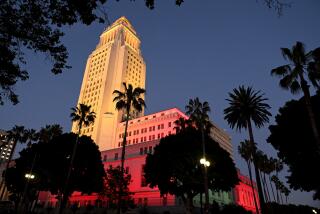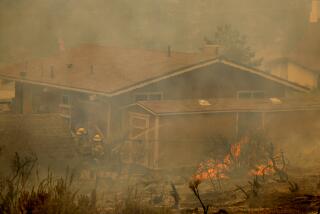Sprinklers Issue Reborn in Ashes : Bank Fire May Do What Vegas, Bunker Hill Tragedies Didn’t
In the wake of the fatal MGM Grand Hotel fire in Las Vegas eight years ago, Los Angeles fire officials urged the City Council to require automatic sprinklers installed in all older high-rise buildings, such as the 62-story First Interstate Bank tower ravaged by flames last week.
But the recommendation, made in a 1981 letter from then-Fire Chief John Gerard to the council’s Police, Fire and Public Safety Committee, languished for nearly three years in the city bureaucracy before it was ultimately killed in a routine--and unanimous--council vote.
City records also show that nearly a year before Gerard’s letter, a task force of experts had also urged that sprinklers be studied after the 1979 Bunker Hill Tower West fire in downtown Los Angeles resulted in three deaths.
Councilmen Ernani Bernardi and Robert Farrell, who participated in the discussions between 1980 and 1983, said Wednesday there was really no strong reason why retrofitting of older high-rises with sprinklers was never pushed by the two council committees that considered the recommendations.
“We don’t really have a legitimate excuse for not doing it. We really don’t,” Bernardi said. Farrell said it is “embarrassing.”
But both council members said last week’s devastating First Interstate Bank fire, in which one person died and 40 others were injured, will provide the impetus for mandatory retrofitting in older high-rise buildings at least 75 feet tall. Automatic sprinklers have been required in any high-rise built since July, 1974.
Fire Chief Donald Manning said a working sprinkler system in the high-rise would have limited damage to a small area on the 12th floor. Without a sprinkler system, the fire spread to four higher floors causing tens of millions of dollars in damage.
On Tuesday, the council ordered the city attorney’s office to draft a mandatory retrofitting ordinance for later consideration. But the action does not guarantee how the council will ultimately act.
Most of the city’s significant fire safety standards have been enacted in the wake of disasters that pointed up weaknesses in existing fire codes. The city requires fire doors, smoke detectors and the like in new high-rises, apartment buildings and hotels largely because of fires in Los Angeles that resulted in deaths.
Never Really Considered
But automatic sprinkler systems, largely due to their costs, were never strongly considered by the council, city records show. The blame for that rests in several areas, including the council committees and the experts, according to city records.
On Nov. 21, 1980, 80 people died and 400 were injured in a fire that struck the MGM Grand in Las Vegas. It was the second-worst hotel fire in the nation’s history.
Three days later, Councilman Zev Yaroslavsky proposed, along with other Fire Code amendments, a study of whether it made sense to retrofit existing high-rises with sprinklers. In a Jan. 30, 1981, letter to then-Councilwoman Peggy Stevenson, who chaired the council’s police and fire panel, then-Fire Chief Gerard and Building and Safety Department General Manager Jack Fratt, who is now retired, also pushed for automatic sprinklers.
They did not, however, say they were absolutely necessary:
“It is the opinion of the Fire Department that the most effective method to control the spread of fire . . . in existing high-rise buildings is by providing fire sprinkler systems throughout the building or by using a combination of fire sprinklers and smoke detectors . . .,” Gerard and Fratt wrote.
They offered the council three varying lists of recommendations, the highest priority being sprinklers throughout every high-rise. Barring that, they urged limited installation of sprinklers in exit ways, storage rooms and above hallway doors.
The Gerard/Fratt letter was placed in a growing City Hall file that had been started after a fire in the luxury Bunker Hill Tower West residential high-rise on Oct. 29, 1979.
Two weeks later, Councilman Gilbert Lindsay sought a study of fire safety measures that could prevent similar disasters.
On April 7, 1980, the Bunker Hill Tower fire task force recommended a number of Fire Code amendments to the council’s Police, Fire and Public Safety Committee. The lengthy report, prepared by then-Chief Legislative Analyst Kenneth Spiker, was lukewarm on whether owners of high-rises should be required to install sprinklers.
The task force concluded that sprinklers “ . . . would be useful, but not cost-effective. . . . We understand that this requirement would be very costly and that combinations of other measures may be nearly as effective at a much lower cost; however, this proposal has been offered several times and your committee may wish to give it some consideration.”
The committee, however, forwarded the report to the full council, and in December, 1980, the council voted unanimously that retrofitting should be studied further.
The opportunity for further study came after the MGM Grand fire--between November, 1980, and November, 1983--but once again the retrofitting recommendations were not given serious consideration.
On Nov. 8, 1983, when the council finally received the Building and Safety Department report dealing with Yaroslavsky’s motion, the vote was unanimous to acknowledge “that many of the recommendations (contained in the April, 1980, task force report) have been implemented or are in the process of being implemented.” The council, including Yaroslavsky, then voted to file the report, effectively killing the retrofitting idea until it was revived last week.
More to Read
Sign up for Essential California
The most important California stories and recommendations in your inbox every morning.
You may occasionally receive promotional content from the Los Angeles Times.










